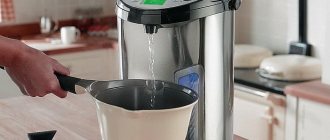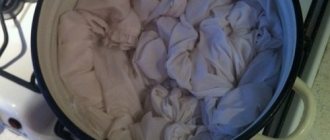A thermopot is a device that heats water and maintains its temperature for a certain time for use at home or in catering establishments - in canteens, cafes and other establishments.
Until recently, thermal pots were a rather exotic type of kitchen appliances, and more often they could be found in self-service canteens, but today the range of devices has expanded significantly. Buyers quickly realized the benefits of this hybrid of a kettle, samovar and thermos, and actively began to buy it for their kitchens.
What is a thermopot
The electric kettle is known to all consumers. The essence of the device always remains the same - the kettle must boil water. Everyone also knows the purpose of a household thermos. Despite the different sizes of these indispensable devices, the function of the thermos does not change - the thermos is designed to maintain the appropriate temperature of the food.
The engineers came up with an idea: to combine the functions of these two devices in one device. This is how the thermopot appeared.
The operating principle of the thermopot is simple. Liquid is poured into the container of the device. The device is turned on and it brings this liquid to a boil. Having reached the boiling point, the device will automatically turn off. Now the device will maintain the temperature in the container within the specified range.
Some models are equipped with filters. They provide a pure drink, without harmful impurities. Typically, thermopots are used for preparing hot drinks such as tea, coffee, mulled wine and others.
Manufacturer
After all the main characteristics have been selected, you still need to decide which company’s device to give preference to. In this matter, you should focus on your material capabilities, because brands are focused on different consumer segments.
- Maxwell, Supra, Scarlett, Polaris are the most budget devices.
- Kitfort, Panasonic, Oursson, Redmond - the optimal combination of price and quality.
- Zojirushi, Rommelsbacher, Caso, Bosch are expensive models with improved functionality.
At the same time, we must not forget that each manufacturer has at least several varieties of goods in different price categories.
In any case, it is better to choose a well-known brand. This way you can minimize the risk of purchasing a low-quality product.
Thermopot device
The thermopot is designed on the basis of an electric kettle. Traditional glass, metal or plastic are used for the body. The weight, as well as the degree of heating of the case, depends on the material.
The electric heating element is no different from the usual ones used in electric kettles. This is still the same spiral or disk. For safety reasons, it is preferable to use a closed disc heater.
The main element of the thermopot design is the container. It is designed in the same way as in a regular thermos. Glass or stainless steel is used to make the container. To better retain heat in the container, its outer surface is coated with special compounds.
In order to pour water, you do not need to lift or tilt the device. There is a button in the body, by pressing which you can pour water into the mug. Some models are equipped with water filters.
Devices are available in different capacities: usually from three to five liters. There are large models, the volume of which can reach 10 liters.
Variety
The market offers various types and sizes of thermopots. First of all, the device is divided according to the material of manufacture.
The units are made from the following materials:
- Plastic device. It has an inexpensive price. It comes in a variety of colors, so you don’t have to worry about matching the device with the interior of the room. Such a unit does not last long; the plastic loses strength over time. And the thermopot loses its appearance;
- Glass unit. Quite a stylish device, but it requires careful care of the glass and careful handling. Since the glass unit is very fragile;
- Metal device. Made from stainless steel and aluminum alloy. Quite durable and versatile devices. They are distinguished by their high price and constant care. After all, hand marks are clearly imprinted on this device;
- Combined unit. Popular buyer model. It has a rather attractive appearance, thanks to several materials for making the thermopot.
These devices also differ in the volume of heated liquid.
Volume
Thermopots are represented by different indicators of the volume of water that they can heat and keep at the same temperature. Devices come in 4 liter capacity. They are recommended for families with children and those who need constant hot liquid for various household needs. Units from 5 to 7 liters are useful in production or for a large family. This thermopot can provide hot liquid for up to 15 people.
The devices also differ in the type of heating element.
Type
Thermopots are produced with two types of heating devices:
- Open spiral. It somewhat resembles an ordinary Soviet boiler. The device of such water heating has a low cost. The unit operates almost silently. But it has such negative aspects as inconvenience when cleaning the device (the spiral is difficult to put in order). And the device cannot be used to heat a small amount of water (the liquid must completely cover the spiral);
- Closed spiral. Located under a special disk in a thermopot. Easy to care for. But it has a higher cost compared to its previous brother. Also, devices with such a heating element consume a lot of electricity and create inconvenience during their noisy operation.
Temperature
Manufacturers offer thermopots equipped with up to 6 different modes for heating the liquid. Devices with modes from 4 to 6 are ideal for families with small children. Units equipped with 3-4 modes are recommended for use by elderly people or large families.
Advantages
These household appliances have absorbed all the advantages of electric kettles and thermoses. The advantages of thermopots include the following capabilities and functions.
- The device is capable of bringing water to a boil or to a specified temperature. The reached temperature will be automatically maintained in the container.
- Adjusting the water heating level. There are usually 4 levels of temperature control. Each level is set at the consumer's discretion.
- The ability to maintain a given temperature for a long time. In this case, you can get hot water at any time. This is very convenient and also saves time.
- All models of thermopots are equipped with electric pumps that fill the mugs without manipulating this rather heavy device. If for some reason the device is without power supply, the built-in hand pump will still allow you to draw water into the mug.
- The case does not heat up. Using it, it is impossible to get burned.
Energy consumption and power
Many people are concerned about the question: does such a device save electricity, or, on the contrary, spend it many times more than a regular kettle? After all, the thermopot is constantly on and requires power, but how much it consumes is unknown.
An economical thermopot consumes 600 W, and the most energy-consuming one consumes 3000 W. The latter are rare, generally the power fluctuates between 0.6 - 0.85 kW per hour.
A sample with a capacity of 4 liters spends 800 W for a full cycle, and 35 W for constant heating. Whereas a 2 liter kettle consumes 2200 W per boiling.
So the savings are obvious.
At the same time, you should not turn off the device in an attempt to reduce energy costs: it will spend much more kilowatts on full heating than on maintaining the temperature. Even the largest units rarely consume more than 100 W/hour.
Flaws
Despite the obvious advantages of these devices, they also have certain disadvantages. These include the following characteristics.
- It will take longer to heat the water than to heat water in a regular electric kettle. This is due to the fact that the capacity of a thermopot is much larger than the capacity of an electric kettle.
- The cost of a thermopot exceeds the cost of a regular electric kettle.
Taking into account the advantages and disadvantages of thermopots, it should be concluded that such devices are more appropriate to use in large families or in offices. For small families, an electric kettle is quite enough.
Housing material
The material of the thermopot body affects two aspects - aesthetic and practical. The metal body of the thermopot is less susceptible to mechanical damage, the outer surface is less abraded during cleaning, and if the body is not painted, it has a natural metal color. A plastic case will not withstand significant mechanical stress, its surface may change its appearance due to careless maintenance, but from an aesthetic point of view it is in no way inferior to a metal one. Whatever material the body of the device is made of, it should under no circumstances become very hot during operation of the thermopot.
How does a thermopot work?
The operating principle of the thermopot is very simple. First you need to pour water into its container. After closing the lid, press the power button of the device. The electric heating element turns on and begins to heat the water. Each thermopot is equipped with a temperature sensor that signals when water is boiling. When the water boils, this sensor is triggered and automatically disconnects the electric heating element from the network.
After turning off the heating element, the water in the tank begins to cool. The design includes another adjustable temperature sensor, set to a certain temperature, which can be changed manually. As soon as the water temperature reaches the set value, the sensor will operate and supply power to the heating element. It will turn on and the water will begin to heat up again. Having reached the boiling point, the first sensor is triggered and the cycle repeats.
In order to fill the mug, you need to press the button that turns on the water supply pump. He begins to pump hot water from the tank into the cup he holds up. The pump only works when the key is pressed. By releasing it, we turn off the water supply.
Principle of operation
After filling the container with water using a jug, closing the lid and pressing the button, heating the liquid in the thermopot occurs in stages:
- The heating element is turned on to heat the water. Once the water reaches the desired temperature, the thermal switch is activated. It comes into contact with the tank and breaks the electrical circuit, as a result of which the temperature rise stops.
- At the next stage, the liquid begins to gradually cool. This continues until a certain temperature value is preset on the control panel. If the user has selected 80 degrees, when the water cools to this temperature the temperature sensor will operate. Then the second heating element will turn on , necessary to keep the water hot.
How to use the device
When using a thermopot, you must follow several general rules, the implementation of which will ensure safety and guarantee long-term operation of the device.
- It is strictly forbidden to fill the device tank directly from the tap. Water is poured from another container. A small ladle or jug is perfect for these purposes. If you don’t have such utensils, you can use a regular mug.
- Water must be added so that its level does not exceed the maximum value. This level is indicated by a mark on the inner surface of the container.
- The lid must be closed tightly, and then connect the device to the network.
- By pressing the “boiling” key we start the unit.
- When the water boils, the device will automatically turn off. Now you need to set the lower limit of the temperature range, upon reaching which the device will turn on again. The corresponding value is set with the “select” key.
If configured correctly, the device will constantly maintain the set water temperature for a long time.
The temperature setting level does not affect the ability to fill the mug. You can do this at any time by pressing the water supply button.
Rating
If you decide to purchase a thermopot, then it is a good idea to use all available sources of information: reviews, advice from sellers, expert articles. Ratings of the best devices will also help you decide. Below I present 3 top models, check them all and pay attention to other products on store sites.
- Maxwell MW-1754W
Holds up to 3.3 liters, while being able to boil water and maintain its temperature at 90 degrees. The combination of electric and mechanical pumps allows you to use the model regardless of the availability of electricity. To protect against scalding, there is an option to turn off the supply.
Cost – 3,490 rubles.
- Redmond RTP-M810S
A very functional thermopot with a stainless steel body, designed for 5 liters. Its main feature is the ability to control it from a smartphone through a special application. Here you can set the on time, select the temperature with an accuracy of 1 degree (there are only three options on the device itself), and turn off the control panel. In addition to heating, it can quickly cool the liquid to room temperature. When pouring, a light point appears in the place where the stream will fall, which eliminates the possibility of it falling past the cup.
You will have to pay 9,900 rubles for all this splendor.
In Eldorado there is now a 1000 rubles discount on the product, it is almost gone.
- Zojirushi CD-JUQ30 CT
High quality Japanese product. Holds 3 liters of water and maintains its temperature at three levels: 70, 90, 98 degrees. It has anti-scale protection and an indication system. The flask is made of metal, and the casing is made of a combination of plastic and stainless steel.
Price – 16,000 rubles.
What to look for when choosing a thermopot
When purchasing such a device, you must first take into account the number of family members. For small families, a 3-liter device is sufficient. If a lot of people will use the thermopot, then it is better to buy a 5-liter model.
Determine the importance of certain additional functions of the unit. Some value more the ability of the device to maintain the desired temperature. Others like devices that don't require tilting to use. Still others choose economical models, which are necessarily equipped with built-in filters.
Carefully study and evaluate the technical characteristics of the unit:
- Volume of the internal reservoir for heating the liquid;
- Power consumption of the electric heating element;
- Temperature adjustment range;
- The presence of a pump for supplying water to the mug;
- Additional options.
Volume
It is difficult to advise anything here, since the volume is selected individually, depending on specific needs. It all depends on the number of people who will use the thermopot, on whether there are often guests, whether there are babies or a big tea and coffee drinker.
For a house with three people, a 3 liter capacity is enough. This amount is enough for one day, and the water will not stagnate and electricity will not be wasted.
For a large family that needs boiling water for various purposes, it makes sense to buy a device that holds 5 or more liters.
If you plan to install the heater in the office, you will need a larger container of 10 liters or more.
Package
Thermal heater DEXP THP-5500 is packed in a rectangular cardboard box. Dimensions 45x35x27 cm. The height of the thermopot itself is approximately 40 cm.
Basic information is written on the box
The top is decorated with a very beautiful pattern. There is a plastic handle here for easy transportation of the box.
Everything fits very tightly in the box itself. To pull out its contents, you need to make a decent effort.
The thermopot is well fixed with polystyrene foam. A recess is made for the spout and handle.
On the outside, a small niche is made in the foam (parallel to the spout). The cord is placed here.
The thermopot itself is tightly wrapped with film. The likelihood of scratching the surface during transportation is minimized.
User manual and warranty card.
Cord 110 cm long. Plug type F, with grounding.
Design Features
To become more familiar with the operation of the device, you should find out how the thermopot works. Outwardly, it resembles an electric kettle rather than a thermos, although it may look more bulky and technologically advanced. This similarity is explained not only by the profile and modes of functioning. Many of the design elements are similar to those present in the prototypes:
- the device is assembled in a metal or plastic case;
- a steel or glass flask made of impact-resistant and heat-resistant glass is borrowed from a thermos;
- there is a pair of spiral heaters in tubes, one of them works for boiling, the second is more economical for heating;
- the heating elements are supplemented with a pair of thermal switches that control the temperature, disconnect the power when the maximum is reached and restore the network when it drops to a minimum;
- an important design element is the pump, which can be made in electrical or mechanical versions;
- the electronics are represented by two boards, one is responsible for supplying power, the second is control;
- the control module is connected to an external control panel located on the housing;
- it may contain setting keys, a display, power and drain buttons;
- In addition to the panel, a dosimeter is located on the outside, which allows you to monitor the filling level of the container.
Devices may have different design nuances, but in general the device is the same; the overall design of the thermopot remains similar, regardless of the model and manufacturer.











